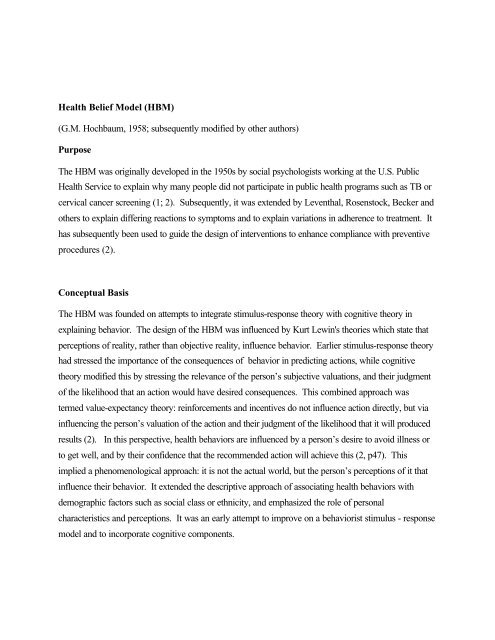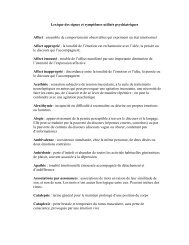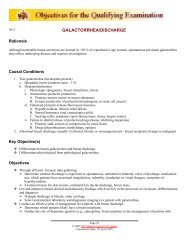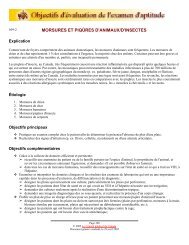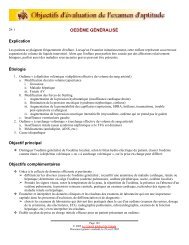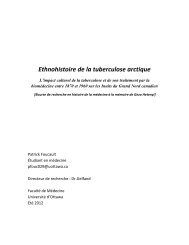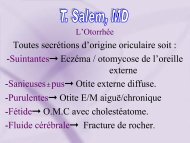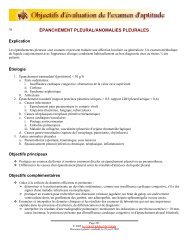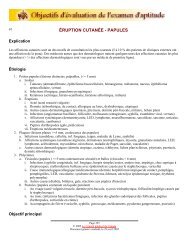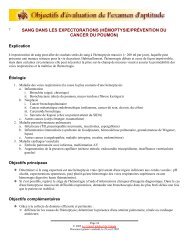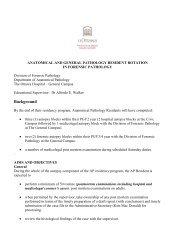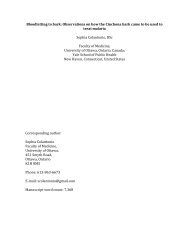Health Belief Model
Health Belief Model
Health Belief Model
Create successful ePaper yourself
Turn your PDF publications into a flip-book with our unique Google optimized e-Paper software.
<strong>Health</strong> <strong>Belief</strong> <strong>Model</strong> (HBM)<br />
(G.M. Hochbaum, 1958; subsequently modified by other authors)<br />
Purpose<br />
The HBM was originally developed in the 1950s by social psychologists working at the U.S. Public<br />
<strong>Health</strong> Service to explain why many people did not participate in public health programs such as TB or<br />
cervical cancer screening (1; 2). Subsequently, it was extended by Leventhal, Rosenstock, Becker and<br />
others to explain differing reactions to symptoms and to explain variations in adherence to treatment. It<br />
has subsequently been used to guide the design of interventions to enhance compliance with preventive<br />
procedures (2).<br />
Conceptual Basis<br />
The HBM was founded on attempts to integrate stimulus-response theory with cognitive theory in<br />
explaining behavior. The design of the HBM was influenced by Kurt Lewin's theories which state that<br />
perceptions of reality, rather than objective reality, influence behavior. Earlier stimulus-response theory<br />
had stressed the importance of the consequences of behavior in predicting actions, while cognitive<br />
theory modified this by stressing the relevance of the person’s subjective valuations, and their judgment<br />
of the likelihood that an action would have desired consequences. This combined approach was<br />
termed value-expectancy theory: reinforcements and incentives do not influence action directly, but via<br />
influencing the person’s valuation of the action and their judgment of the likelihood that it will produced<br />
results (2). In this perspective, health behaviors are influenced by a person’s desire to avoid illness or<br />
to get well, and by their confidence that the recommended action will achieve this (2, p47). This<br />
implied a phenomenological approach: it is not the actual world, but the person’s perceptions of it that<br />
influence their behavior. It extended the descriptive approach of associating health behaviors with<br />
demographic factors such as social class or ethnicity, and emphasized the role of personal<br />
characteristics and perceptions. It was an early attempt to improve on a behaviorist stimulus - response<br />
model and to incorporate cognitive components.
Description<br />
The HBM breaks down health decisions into a series of stages and offers a catalogue of variables that<br />
influence health action; it does not provide a model of exactly how these operate. In the HBM, the<br />
likelihood that a person will follow a preventive behavior is influenced by their subjective weighing of<br />
the costs and benefits of the action; the perception involves the following elements:<br />
Perceived susceptibility: the person’s judgment of his or her risk of contracting the condition.<br />
This might be measured by questions such as “Taking all factors into account, what do you<br />
think are your chances of getting [the disease]?”<br />
Perceived seriousness of the condition: the severity of the of the condition (its clinical<br />
consequences, disability, pain or death) and its impact on life style (working ability, social<br />
relationships, etc.). Questions might include “If you got [the disease], how serious would that<br />
be?” Or, more objective indicators might be used, such as the number of days off work or in<br />
bed.<br />
The combination of perceived susceptibility and seriousness is termed perceived threat (see Figure 1).<br />
The perceived threat has a cognitive component and is influenced by information. It creates a pressure<br />
to act, but does not determine how the person will act. That is influenced by the balance between the<br />
perceived efficacy and cost of alternative courses of action:<br />
Perceived benefits of an action: will the proposed action be effective in reducing the health risk?<br />
Does this course of action have other benefits? Again, it is the person’s beliefs, rather than<br />
factual evidence, that is influential. The beliefs will reflect social and cultural influences.<br />
Assessments might include “Do you think there is anything that could be done to prevent this<br />
condition? How effective would that be?”<br />
Perceived barriers to action: How do these benefits compare to the perceived costs of action?<br />
Are there barriers to action? Will it involve expense, pain, or embarrassment? This can be<br />
assessed via questions such as “What difficulties do you see in undertaking this action?” An<br />
11-item barrier scale for adopting preventive behaviors for AIDS was published by Maguen et<br />
al. (3). Note that there may be difficulties in scoring such responses, and the barriers<br />
mentioned may be quite independent of each other.<br />
The balance between benefits and costs may suggest the person’s likelihood of acting and their<br />
preferred course of action, but do not necessarily determine that they will act. Indeed, if benefits are<br />
closely balanced against costs the person may vacillate, perhaps experiencing anxiety. The final
ingredient in the HBM was therefore:<br />
A stimulus or cue to action. When a person is motivated and can perceive a beneficial action to<br />
take, actual change often occurs when some external or internal cue (e.g., a change in health,<br />
the physician’s advice, or a friend’s death) triggers action. As cues may be fleeting events they<br />
are elusive to record (2, p50). The magnitude of the cue required to trigger action would<br />
depend on the motivation to change and the perceived benefit to cost ratio for the action (1).<br />
Although Hochbaum saw cues as being crucial, they have rarely been studied empirically.<br />
Perceived Susceptibility<br />
to Disease<br />
Perceived Severity<br />
of Disease<br />
Cues to Action<br />
· Raised awareness (e.g., mass media<br />
campaign, newspaper article )<br />
· Personal advice (e.g., reminder from<br />
health professional)<br />
· Personal symptoms<br />
· Illness of family member or friend<br />
Perceived Threat<br />
of the Disease<br />
Modifying Factors<br />
· Demographics (age, sex, ethnicity, etc.)<br />
· Sociopsychologicalvariables (personality,<br />
social class, peer and reference group<br />
pressures, etc.)<br />
· Structural variables (knowledge about<br />
the disease, prior experience of it, etc.)<br />
Perceived benefits of<br />
taking action, minus<br />
Perceived barriers to<br />
action<br />
Likelihood of Taking<br />
Recommended <strong>Health</strong> Action<br />
Figure 1. The variables in the <strong>Health</strong> <strong>Belief</strong> <strong>Model</strong>. Adapted from Rosenstock, Janz and others (1; 2)<br />
It is clear that the HBM focuses on avoiding disease rather than on achieving health. Rosenstock noted<br />
that this was in part due to the difficulty in framing questions in terms of positive health.
Validity<br />
Few of the studies that have evaluated the HBM provide results that can be summarized numerically.<br />
As early as 1974, Rosenstock reviewed seven studies that had evaluated the HBM (4). Six lent<br />
“support to the importance of several of the variables in the model as explanatory or predictive<br />
variables. However, a seventh major investigation conflicted in most respects with the findings of earlier<br />
studies.” (4, p364). Rosenstock noted that the first six studies were undertaken following widespread<br />
public advertising alerting the public to particular health issues; the seventh study was undertaken in the<br />
absence of any campaign. Rosenstock concluded that the HBM can predict voluntary health behavior<br />
in people who are essentially healthy.<br />
Janz and Becker’s review showed that prospective studies supported the predictive validity of the<br />
HBM, as did several cross-sectional studies (5). Perceived barriers appear as the single best predictor<br />
of subsequent behavior. Janz et al. reported on a series of studies that evaluated the HBM in predicting<br />
uptake of mammography screening, and also reviewed several studies that used it in designing<br />
interventions to increase screening (2, p54). They concluded that interventions that incorporated the<br />
HBM precepts tended to produce superior results, but it is often not possible from the studies to isolate<br />
the effects of the HBM from other characteristics of the intervention.<br />
Rosenstock also noted that positive health beliefs as described in the HBM are more likely to occur<br />
among middle class people who have a future orientation, who make deliberate plans and favor long-<br />
term goals over immediate gratification.<br />
Alternative Forms<br />
Reactions to the HBM suggested that it held merit, but explained rather little variance. Accordingly,<br />
many derivatives have been proposed. Examples include Langlie’s model that included perceived<br />
vulnerability, perceived benefits of changing health behavior, barriers & costs, health locus of control,<br />
socioeconomic status, and situational constraints.<br />
Antonovsky and Kats proposed a model of preventive health behavior that built on the HBM and<br />
included three classes of variables (6). ‘Predisposing motivation’ was influenced by the desire to avoid<br />
illness, to gain approved by others and to pursue personal values. ‘Blockage variables’ included a lack<br />
of knowledge and resources. ‘Conditioning variables’ included factors that modify the above variables,
such as perceived susceptibility, SES, and previous illness experience. In this theory, cognitive factors<br />
operate chiefly by modifying motivation. This approach differed from the HBM in that it explicitly<br />
included motivation and also replaced the linear associations between the factors and health behaviors<br />
by a threshold model.<br />
David Mechanic proposed ten types of influence on behavior, most referring to the first stages of the<br />
HBM: frequency and visibility of symptoms; their seriousness; the person’s tolerance threshold; their<br />
level of knowledge; the availability of treatment and constraints on action (such as job demands).<br />
Cummings et al. reviewed 14 models of health behaviors and asked eight experts judge the similarity of<br />
the variables they contained. From this, a form of multidimensional scaling produced six categories of<br />
variables: Accessibility of health services; Attitudes towards health care; Threat of illness; Knowledge<br />
about disease; Social network factors (e.g. social pressures, support, traditions); Demographic factors<br />
(SES, etc) (7).<br />
Commentary<br />
The HBM is generally taken as marking the beginning of systematic and theory-based research on<br />
health behavior. It has been widely used and applied to explaining health behaviors as well as used to<br />
design intervention programs. It has been used in cross-cultural studies, although its constructs may<br />
need to be adapted to each cultural group. Tang et al., for example, studied cultural barriers in<br />
participation in cancer screening among Chinese and Asian peoples in the U.S. (see (2, p59).<br />
The perceived benefits of the HBM resemble Bandura’s concept of outcome expectations (2).<br />
Following Bandura’s development of social learning theory, Rosenstock et al. suggested that self<br />
efficacy be added to the HBM, to cover the person’s sense of confidence that they could successfully<br />
change behavior to produce the desired outcomes. As Janz et al. note, however, this represents an<br />
extension of the original purpose of the HBM, for it originally applied to single actions such as receiving<br />
an immunization, while self efficacy is most relevant to health actions that require sustained effort, such<br />
as smoking cessation (2, pp50-51). The HBM does not cover habitual behaviors or those constrained<br />
by custom and tradition. Cognitive models focus on voluntary health behaviors, but when behaviors are<br />
legislated or required (as with health checks as a condition of employment) they will not apply. Social<br />
pressure may also modify behaviors, and this lies beyond the scope of most models of health behavior.<br />
Among limitations of the HBM, Janz et al. noted that the concepts have been inconsistently and often<br />
poorly measured (2, p52), making it difficult to draw comparisons across studies. But this criticism may
e misplaced, because measures of concepts such as barriers to action cannot be measured generally,<br />
but have to be specific to particular behaviors. The HBM describes constructs that predict behaviors,<br />
but it says nothing of how these are expected to interrelate. Do they follow an additive or a<br />
multiplicative model? What time frame is anticipated across the various components of the model?<br />
Janz et al. suggested several testable hypotheses that could guide further testing of the structural<br />
characteristics of the HBM (2, pp60-61).<br />
References<br />
(1) Rosenstock IM. Historical origins of the <strong>Health</strong> <strong>Belief</strong> <strong>Model</strong>. <strong>Health</strong> Educ Monogr 1974;<br />
2:328-335.<br />
(2) Janz NK, Champion VL, Strecher VJ. The <strong>Health</strong> <strong>Belief</strong> <strong>Model</strong>. In: Glanz K, Rimer BK,<br />
Lewis FM, editors. <strong>Health</strong> behavior and health education: theory, research, and practice. San<br />
Francisco: Jossey-Bass, 2002: 45-66.<br />
(3) Maguen S, Armistead LP, Kalichman S. Predictors of HIV antibody testing among gay,<br />
lesbian, and bisexual youth. J Adolesc <strong>Health</strong> 2000; 26:252-257.<br />
(4) Rosenstock IM. The <strong>Health</strong> <strong>Belief</strong> <strong>Model</strong> and preventive health behavior. <strong>Health</strong> Educ Monogr<br />
1974; 2:354-386.<br />
(5) Janz NK, Becker MH. The <strong>Health</strong> <strong>Belief</strong> <strong>Model</strong> a decade later. <strong>Health</strong> Educ Q 1984; 11:1-<br />
47.<br />
(6) Antonovsky A, Kats R. The model dental patient: an empirical study of preventive health<br />
behavior. Soc Sci Med 1970; 4:367-380.<br />
(7) Cummings KM, Becker MH, Maile MC. Bringing the models together: an empirical approach<br />
to combining the variables used to explain health actions. J Behav Med 1980; 3:123-145.


